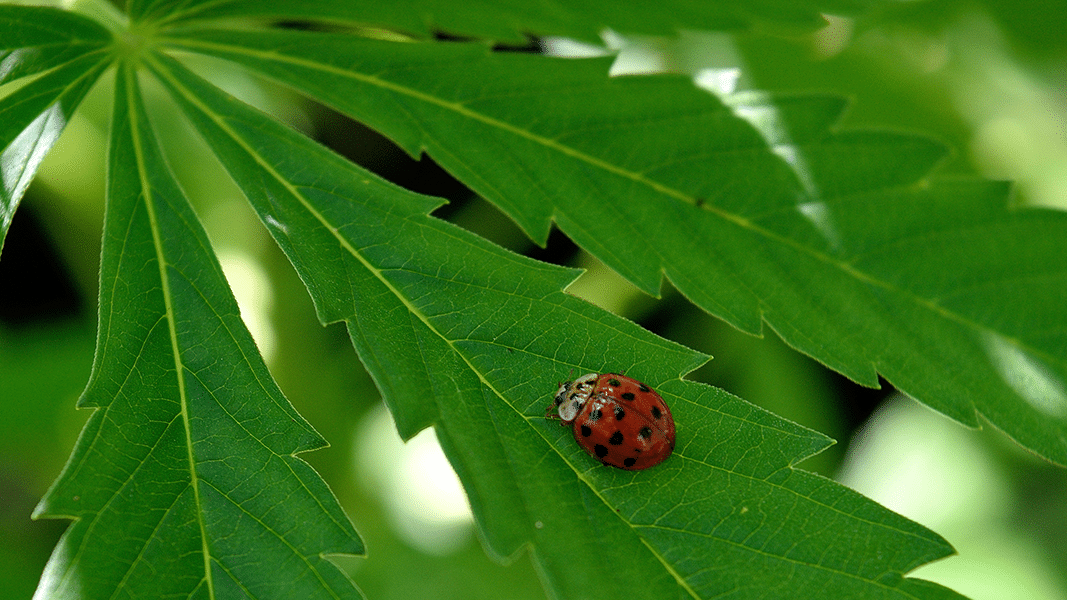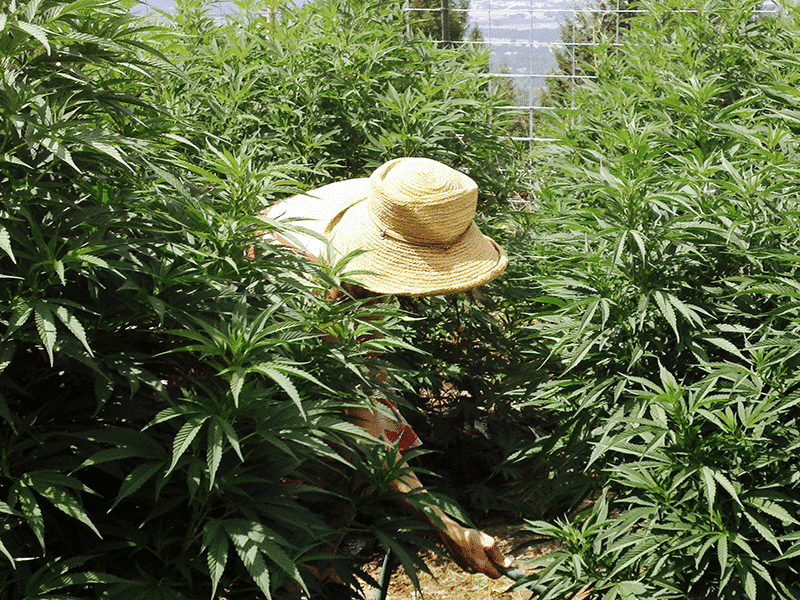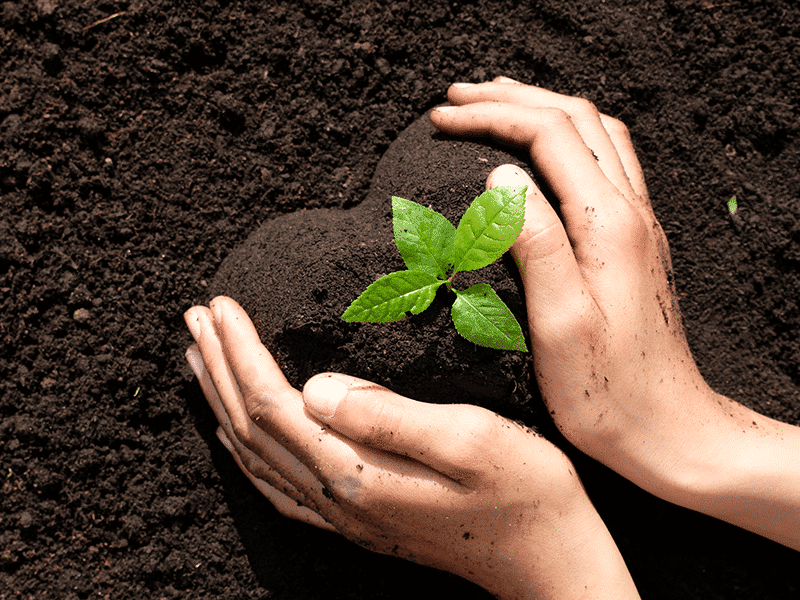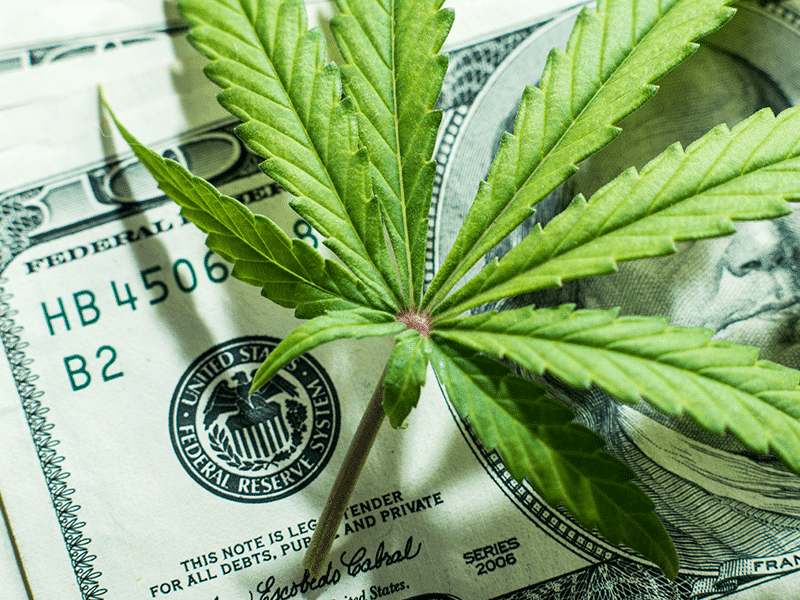Terrance Planty bends over a hügelkultur-style garden bed bursting with fava beans and surrounded by half-decomposed hay bales. He thrusts his arm into the soil and lifts up a handful of dark, earthworm-strewn goodness. “This is where it all starts,” he says.
Terrance and his wife Elise Planty are cannabis farmers. With another couple, they co-own Starflower Farms, situated on a fairytale-like swathe of land in Covelo, California, about 180 miles north of San Francisco.
It’s been just weeks since I interviewed the Plantys, and everything has changed in the world, seemingly overnight. Like almost everyone else in much of the country right now, the Plantys are under shelter-in-place orders due to the COVID-19 virus. But other than social distancing in their isolated Mendocino County town, nothing is much different for the couple and their three children. Since cannabis cultivation is allowed under the current state work restrictions, they still get up every day to work on their farm, ringed by mountains sprinkled with blossoming red bud trees and golden California poppies.
Growing cannabis is deeply personal for the Plantys. They are committed to using regenerative farming techniques that include fertilizing with their own livestock manure and compost, and companion planting with indigenous flora that attract beneficial insects or deter predators. During pre-COVID times they took part in a local cannabis farmer’s community group, sharing tools, seeds, expertise, and support.
“I love all aspects of the process,” says Terrance. “Sure, I love the flowers, but working with the soil is just as satisfying.” He likes to align his garden work with the lunar cycles and the Farmer’s Almanac. “Growing cannabis is a journey,” he says. “My own personal unfoldment parallels the cycles of growth and is enhanced by my communication with the plants.”
It all sounds so idyllic, especially right now.
Bonding with Nature
During these uncertain times of crisis and quarantine, many of us have come down with a bad case of cabin fever. Even the U.S. government recently acknowledged the importance of getting outside every day during lockdown, if just for a walk or bike ride around the neighborhood, or to work in the garden.
Spending time in nature is an intrinsic human need. Harvard entomologist and biodiversity expert E.O. Wilson coined the term “biophilia” to describe the “innate human tendency to focus on life and lifelike processes” and to bond with the natural world. “Our existence depends on this propensity,” Dr. Wilson wrote. “Our spirit is woven from it, hope rises on its currents.”
Recent research has confirmed what we’ve known all along: humans are hardwired to interact with nature on a daily basis. If we don’t, our health suffers.
The evolutionary process that led to the emergence of anatomically modern humans took 6 -7 million years and 99 percent of this time was spent in natural surroundings, according to a 2016 review by Japanese scientists in the International Journal of Environmental Research and Public Health. “The gap between the natural setting,” the article explains, “for which our physiological functions are adapted, and the highly urbanized and artificial setting that we inhabit, is a contributing cause of the ‘stress state’ in modern people.”
The review goes on to evaluate current studies and concludes that the beneficial effects of “nature therapy” (including time spent in gardens, forests, and urban green spaces) extend to the central nervous system, autonomic nervous system, endocrine system, and immune system.
Two experiments described in Psychological Science demonstrate “the restorative value of nature as a vehicle to improve cognitive functioning.” According to this report, the brain uses “indirected attention” to process information in a natural environment, thereby giving a needed rest to the part of the brain responsible for “directed attention” that typically occurs in stimulating urban environments. Taking a “nature break” rebuilds depleted cognitive functions, improving attention and memory.
So science says it’s good for our brains to play in parks or go camping; fish in oceans, lakes and streams; surf the waves and walk on the beach, and take “forest baths.” Sadly, during the current global crisis it’s not possible for many of us to take part in the nature activities we might previously have taken for granted.
But what about our backyard gardens? Can mucking about in the dirt really be so beneficial? Apparently it is – and some people have actually developed a specific methodology for using gardening as medicine.
Gardening as Medicine
“Horticultural therapy” is defined as a process — either active or passive — of using plants and gardens to enhance and improve mood, cognitive abilities, self-esteem, and social interactions. According to the American Horticultural Therapy Association (AHTA), it can also strengthen muscles and improve physical skills, as well as help people learn to work independently, solve problems, and follow directions.
Headquartered in Seattle, Washington, the AHTA recommends that horticultural activities be facilitated by a registered “horticultural therapist” or another professional with training in the use of “plant-dominated open spaces” that “exploit the most complete range of people/plant interactions and experiences possible within their enclosures.”
To some of us, the idea of a unique therapeutic activity requiring specially designed gardens under the guidance of trained professionals might come across as overly academic and a bit rigid. But it’s also an understandable response to the nature deficit experienced by many people in the modern world. The demise of nature as the daily context of human existence has made us sick – and we need to recover.
Even simple gardens can be therapeutic, especially for one’s mental health. In a 2011 study, a group of clinically depressed patients took part in a 3-month gardening program that included preparing soil, planting seeds, watering, and maintenance. After 12 weeks, depression severity had decreased. Participants described the program as “meaningful and influential for their view of life.” Another study, entitled “Horticultural Therapy Program for People with Mental Illness,” showed that gardening is “effective in increasing mental well-being, engagement, and the sense of meaningfulness and accomplishment.”
The Green Skills Program, part of the Urban Resources Initiative at the Yale School of Forestry and Environmental Studies, dispatches crews of at-risk youth or former prison inmates “to plant and maintain trees, learn about local ecology, serve as group leaders, and collaborate with peers, all in an effort to improve New Haven’s street tree canopy.” By greening their environment, participants experience a newfound sense of wonder and appreciation for their neighborhoods. Many of them speak of forming bonds with certain trees that last over time.
Beautiful Artistic Creations
In the past, gardens throughout the world had many purposes. Gardens produced food, medicine, clothing, and other elements of survival. Some gardens provided a sacred outdoor confine for spiritual practice. Others offered space for sports and recreation or were used for cultural or civic events. Many gardens of yore were beautiful artistic creations, early forms of aesthetically pleasing landscape architecture.
Healing gardens have been grown since ancient times, with earliest evidence of their existence found in Egypt, China, and the Aztec regions in Central Mexico. Later, the “apothecary,” “physic” or “infirmary” gardens of the Middle Ages (precursors to modern botanical gardens) were training grounds for monks and physicians, who relied on plants for medicine.
Though the design and purpose of gardens has evolved over centuries, they still offer many benefits, allowing us to employ all five senses and inviting curiosity, awe, delight, relaxation, and joy. Most importantly, growing a garden gives us a chance to reacquaint ourselves with our place in the wider web of life, to become more aware of how it sustains us, and to take part in ways that transform and heal. This can be particularly true when cultivating an aromatic cannabis garden.
“When someone grows a plant, you get more than a beautiful plant. You get a beautiful person,” says Charles Lewis, a therapeutic horticulture advocate who as a child considered plants to be his “secret friends.”
Mindfully Growing Your Own
For Valerie Corral of Santa Cruz, California, cannabis cultivation has long been in her “heart of hearts.” After a devastating accident in 1973 that left her with a serious brain injury, Corral discovered that cannabis was the only medicine that could alleviate her grand mal seizures. In 1993, she founded Wo/Men’s Alliance for Medical Marijuana (WAMM), growing and giving away medicinal cannabis to patients with severe and life-threatening illnesses.
If they were physically able, WAAM members shared in the joys of tending an outdoor garden. This was integral to the organization’s mission, which states, “From each according to their ability, to each according to their needs.” Everyone contributed in some way to preparing their own medicine — watering plants, trimming the flowers, baking infused muffins, making cannabis rubbing oil and ointments. The buds were kept for smoking; every other part of the plant was used in a variety of forms.
“When we grow our own cannabis medicine,” says Corral, “we expand our relationship with the plant, and with nature itself. Growing becomes a devotional practice, an expression of gratitude for the many gifts of cannabis.”
But ever since California legalized the plant for adult (not just medical) use, regulations have tilted in favor of industrial cannabis operations rather than regenerative farming and mom-and-pop endeavors. The new regime has been challenging for Corral’s organization.
Although Senate Bill 54 recently reinstated “compassionate care” (free medicine) as a limited option for needy Californians, it’s currently illegal for a licensed cannabis product-maker to procure plant materials from an unlicensed grower. Instead, every plant has to be numbered and tracked, then delivered as bud or an oil extract product by licensed third party distributors, then sold to customers by licensed retail outlets, and taxed all along the way.
To Corral, these regulations are antithetical to the spirit of generosity and community for which WAMM is known. “We need to assign a value not just to commodities but to human beings, nature, and the freedom and protection of both,” she says.
Intention, Observation, Patience
DJ Short, an Oregon-based cannabis breeder known for his meticulously crafted cultivars (including the original “Blueberry”) feels that growing cannabis is an opportunity to cultivate intention, observation, and patience. According to Short, cannabis grown solely for potency and profit often lacks the nuanced qualities that make a truly exceptional cultivar. He believes that growers who take shortcuts, use heavy chemicals or engage in unsavory business practices, may end up with weed that tastes of unflushed fertilizers and a “sinister vibe.”
The final product, says Short, “is a mirror of the person who grows it.”
Short’s approach to cultivation is more artistic than scientific. From his Romani grandmother he learned to pop seeds into his mouth before germination as a way to introduce himself to a plant, and to work in the garden barefoot to maintain that connection.
Short cautions against becoming “mesmerized by a pretty plant,” mistaking its height, color or fragrance as signifiers of the final product. Choosing the best medicine, he maintains, takes many months of sampling and observing a cured flower’s effects in all manner of situations. The long term and mindful commitment to the whole cycle — from planning, soil building and germination through growth, harvest, curing, and consumption — is what makes cultivating cannabis so endlessly interesting. But Short shares Valerie Corral’s concern that today’s industrial-scale cannabis agriculture prioritizes profit over personal transformation.
Strength, Compassion, Love
For Elise Planty of Starflower Farms, cultivating cannabis is the natural result of a long personal history with the plant. Planty discovered marijuana as a teenager, marooned and despondent on a naval base in Virginia. Getting high on cannabis expanded her sense of possibility, giving her strength and inspiration during a time when her life circumstances felt severely limiting.
For Planty, her personal journey with cannabis that began during her teen years still unfolds today, and infuses her work on the farm. During the growing season, Planty likes to bestow each row of plants with a particular attribute, be it Strength, Compassion or Love. She says the practice helps her focus on developing those qualities in herself while she works, and hopes that by articulating them, the same will blossom forth in the properties of the final product.
“Walking through the garden in bloom, smelling the flowers, giving them my attention and energy. It feeds my soul, and the plants respond,” Planty muses. “It’s reciprocal.”
Dirty Hands, Healthy Minds
Erika Winters is a writer, speaker, and organic farming consultant who specializes in cannabis cultivation. Winters attended a program in horticultural therapy (HT) and incorporates its principles when teaching people how to grow ganja. Winters says her formal HT training confirmed and augmented much of what she had already learned during years of growing cannabis.
Some of Winters’ clients suffer from a traumatic brain injury or a cognitive disorder, making it difficult to absorb and recall information learned through auditory input. This is where Winters will draw upon HT principles. When teaching about soil composition, for example, she might employ kinaesthetic and visual learning techniques.
“We’re not just talking about soil, our hands are in it, handling sand, silt, humus, clay, making a slurry of native soil and analyzing it by feel,” she says. “Or I’ll have my clients draw pictures of what we’re talking about,” which logs it in their visual memory. Working directly in a garden helps them grasp and retain knowledge while rebuilding cognitive functions that may have been compromised.
Winters, a self-described “Quaker/Buddhist/pagan,” feels that all aspects of cannabis gardening are opportunities to “tune into nature,” the benefits of which science is finally acknowledging. She mentions a report by British researchers who found that exposure to a bacteria common in garden soil may affect the brain in a similar way as antidepressants. This is one of many studies that validate what cannabis growers have known experientially for some time – that caring for, observing, smelling, touching, even talking to their plants is truly healing.
Winters’ ultimate goal is to help improve her clients’ sense of dignity and purpose while feeling less daunted by illness and learning disabilities. By teaching skills to cultivate cannabis therapeutically, Winters invites growers to take responsibility for their own health, uncover hidden talents, accomplish goals, and harvest something valuable at the end of the season: a low-cost, forgiving, self-empowering medicine.
Sounds like something we could all use right now.
Melinda Misuraca is a Project CBD contributing writer with a past life as an old-school cannabis farmer specializing in CBD-rich cultivars. © Copyright, Project CBD. May not be reprinted without permission.
Sources
- American Horticulture Therapy Association. www.aha.org
- Berman, Marc & Jonides, John & Kaplan, Stephen. (2009). The Cognitive Benefits of Interacting with Nature. Psychological Science. 19. 1207-12. 10.1111/j.1467-9280.2008.02225.x.
- Campbell, Gordon. A Short History of Gardens. Oxford University Press, 2017.
- Collins, Minta. Medieval Herbals: The Illustrative Traditions (British Library Studies in Medieval Culture). University of Toronto Press, 2000.
- Gonzalez MT, Hartig T, Patil GG, Martinsen EW, Kirkevold M. A prospective study of existential issues in therapeutic horticulture for clinical depression. Issues Ment Health Nurs. 2011;32(1):73–81. doi:10.3109/01612840.2010.528168
- Hill, Arthur W. (February–April 1915). “The History and Functions of Botanic Gardens.” Annals of the Missouri Botanical Garden.
- Holmes, Edward M. (1906). “Horticulture in Relation to Medicine.” Journal of the Royal Horticultural Society.
- Lowry CA, Hollis JH, de Vries A, et al. Identification of an immune-responsive mesolimbocortical serotonergic system: potential role in regulation of emotional behavior. Neuroscience. 2007;146(2):756–772. doi:10.1016/j.neuroscience.2007.01.067
- Morita E, Fukuda S, Nagano J, et al. Psychological effects of forest environments on healthy adults: Shinrin-yoku (forest-air bathing, walking) as a possible method of stress reduction. Public Health. 2007;121(1):54–63. doi:10.1016/j.puhe.2006.05.024
- Song C, Ikei H, Miyazaki Y. Physiological Effects of Nature Therapy: A Review of the Research in Japan. Int J Environ Res Public Health. 2016;13(8):781. Published 2016 Aug 3. doi:10.3390/ijerph13080781
Recommended Readings
Luther Burbank, Cannabis & Me
The life and times of a CBD-rich garden in Northern California.
Healthy Soil, Healthy Gut, Healthy Brain
Project CBD interviews Kelly Dunn and Josh Sarvis about sustainable and regenerative growing practices.
Growing Pains: Can Sustainable Farmers Survive Legalization?
Part 3 of our 3-part series: Green Rush Blues: California Cannabis After Legalization













